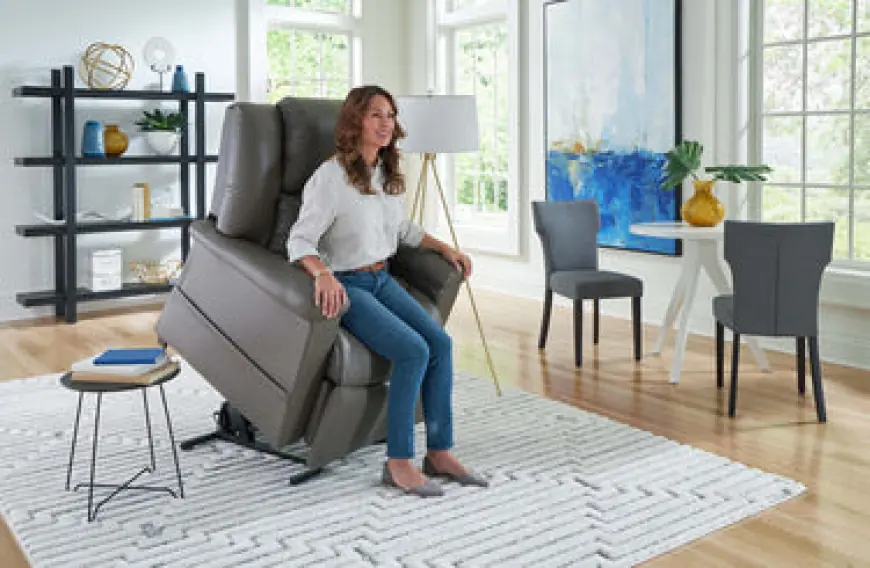Tips to Choose the Best Power Wheelchair for Your Needs
When mobility becomes a challenge due to age, injury, or a medical condition, the power wheelchairs can restore a sense of freedom, comfort, and independence. Unlike manual wheelchairs, power wheelchairs are battery-operated and controlled via a joystick or touchpad, making them ideal for people who have limited strength or stamina. But with a wide range of options, features, and prices available, choosing the best power wheelchair can feel overwhelming.

When mobility becomes a challenge due to age, injury, or a medical condition, the power wheelchairs can restore a sense of freedom, comfort, and independence. Unlike manual wheelchairs, power wheelchairs are battery-operated and controlled via a joystick or touchpad, making them ideal for people who have limited strength or stamina. But with a wide range of options, features, and prices available, choosing the best power wheelchair can feel overwhelming.
Whether you need a wheelchair for daily use, recovery, or occasional outings, selecting the right model is essential for safety, comfort, and convenience. In this article, we’ll explore key tips to help you choose the best power wheelchair for your specific needs.
1. Determine Your Primary Usage
Start by identifying how and where you’ll use the power wheelchair most often. Are you planning to use it indoors, outdoors, or both? For example:
-
Indoor Use: If you’ll mainly be navigating tight hallways, doorways, and small rooms, opt for a compact, tight-turning model with smaller wheels and a narrow frame.
-
Outdoor Use: If you’ll be using the chair on uneven terrain, sidewalks, or for longer trips, look for rugged models with larger wheels, suspension systems, and higher ground clearance.
-
Mixed Use: Consider a mid-wheel drive model that balances maneuverability and outdoor capability.
Understanding your environment will help you eliminate models that don’t suit your daily needs.
2. Choose the Right Drive Type
Power wheelchairs come in three primary drive types:
-
Rear-Wheel Drive (RWD): Offers high speed and better stability on outdoor terrain. However, they have a wider turning radius and are less agile indoors.
-
Mid-Wheel Drive (MWD): Known for the tightest turning radius, ideal for indoor use. MWD chairs offer excellent control and balance but may struggle slightly on rough terrain.
-
Front-Wheel Drive (FWD): Provides good maneuverability and traction, especially for climbing curbs or navigating uneven surfaces. It’s a solid option for both indoor and outdoor use.
Evaluate your home layout, lifestyle, and strength before selecting a drive system that matches your needs.
3. Evaluate Comfort and Seating Options
Comfort is crucial, especially if you’ll be spending long hours in the chair. Pay attention to the following:
-
Seat Cushioning: Look for pressure-relieving cushions, gel inserts, or memory foam seats.
-
Backrest Support: Consider adjustable or reclining backrests for users with posture or spinal support needs.
-
Leg and Foot Rests: Ensure they are adjustable and comfortably positioned. Some models offer elevating leg rests, which are ideal for individuals with circulation issues.
-
Customizable Seating: If you have specific medical conditions, ask about orthopedic seating, tilt-in-space options, or lateral supports.
Test the seating (if possible) or look for detailed product reviews to ensure optimal support and comfort.
4. Check Battery Life and Travel Range
Power wheelchairs run on rechargeable batteries, and range can vary widely based on the model and terrain. Some key considerations:
-
Daily Usage Needs: If you’ll use the chair throughout the day, select a model with a longer battery range (15–20 miles per charge).
-
Travel Requirements: For those who travel or enjoy long outings, choose models with extended battery life and the option for a backup battery pack.
-
Charging Time: Look for chairs with fast charging options to reduce downtime.
Always ask how battery performance is affected by weight, terrain, and incline.
5. Prioritize Portability and Storage
If you need to transport the chair in a car or store it in a small space, choose a folding power wheelchair or a lightweight travel model. Features to consider:
-
Foldable Design: Compact and easy to collapse for travel.
-
Detachable Parts: Some models let you remove the battery, seat, or armrests for easier storage.
-
Weight: Lightweight chairs are easier to lift into vehicles, especially important for caregivers.
Examples include models like the Feather Power Chair or Pride Jazzy Passport, designed for users on the go.
6. Review Control Features and Ease of Use
Most power wheelchairs use joystick controls mounted on the armrest, but features can vary:
-
Joystick Sensitivity: Can it be adjusted for different hand strengths or dexterity?
-
Control Positioning: Can the joystick be mounted on either side for left- or right-hand users?
-
Advanced Controls: Some models offer head control, sip-and-puff systems, or touchscreens for users with severe mobility challenges.
Choose a model that aligns with your ability and preferences for controlling the chair.
7. Assess Weight Capacity and Seat Dimensions
Power wheelchairs come with different weight capacities, ranging from standard (up to 300 lbs) to heavy-duty (up to 600 lbs). Make sure the chair you choose can safely support your body weight. Also consider:
-
Seat Width and Depth: Ensure a proper fit to avoid discomfort or pressure sores.
-
Armrest and Footrest Spacing: Look for adjustable features to customize your sitting position.
A poorly sized wheelchair can cause posture problems and limit mobility, so getting the right dimensions is essential.
8. Consider Your Budget and Insurance
Power wheelchairs can cost anywhere from $1,500 to over $10,000 depending on features and customization. Consider the following:
-
Insurance Coverage: Check if Medicare, Medicaid, or private insurance covers part of the cost.
-
Rental Option: If the wheelchair is only needed temporarily, renting can be a cost-effective alternative.
-
Financing Plans: Some medical supply stores offer payment plans to ease the financial burden.
Always compare prices from different suppliers and understand what’s included in the warranty.
Final Thoughts
Choosing the best power wheelchair involves more than just picking a popular model—it’s about finding the one that suits your unique lifestyle, physical needs, and mobility goals. From maneuverability and comfort to battery range and weight capacity, every detail matters in ensuring your safety and independence. Affinity Home Medical offers the best power wheelchairs to support your daily life.
Take your time to research, consult a mobility expert or occupational therapist, and, if possible, try out a few models. Whether you opt for a folding power wheelchair for travel or a mid-wheel drive chair for indoor maneuverability, the right choice will empower you to live more freely and confidently every day.
What's Your Reaction?
 Like
0
Like
0
 Dislike
0
Dislike
0
 Love
0
Love
0
 Funny
0
Funny
0
 Angry
0
Angry
0
 Sad
0
Sad
0
 Wow
0
Wow
0



















































